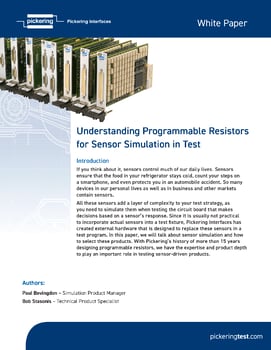If you think about it, sensors control much of our daily lives. Sensors ensure that the food in your refrigerator stays cold,  count your steps on a smartphone, and even protects you in an automobile accident. So many devices in our personal lives as well as in business and other markets contain sensors.
count your steps on a smartphone, and even protects you in an automobile accident. So many devices in our personal lives as well as in business and other markets contain sensors.
All these sensors add a layer of complexity to your test strategy, as you need to simulate them when testing the circuit board that makes decisions based on a sensor’s response. Since it is usually not practical to incorporate actual sensors into a test fixture, Pickering Interfaces has created external hardware that is designed to replace these sensors in a test program. In this paper, we will talk about sensor simulation and how to select these products. With Pickering’s history of more than 15 years designing programmable resistors, we have the expertise and product depth to play an important role in testing sensor-driven products.
Learn the right questions to ask when testing sensor-driven products.
- What is a programmable resistor and why is it used for sensor simulation in test?
- What are the different types and parameters for programmable resistors?
- What if I need more accuracy in my test?
- Are there different types of configurations I can use?
As you can see, there are many things to consider when selecting programmable resistor modules in test. It is undeniable that sensors are in virtually every application for electronics, making testing important, and sensor simulation can help you get there. We recommend you take a look at our latest whitepaper -
Understanding Programmable Resistors for Sensor Simulation in Test
To learn more, take a look at our web page: Programmable Resistor Solutions for Sensor Simulation or contact our simulation application engineers.